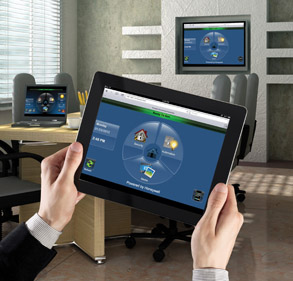 |
| Photo Courtesy of Honeywell |
While the U.S. economy as a whole struggled to make modest gains in 2012, for the home automation industry, it was a good year. Now with a rebound in new home construction and consumers’ insatiable appetite for new ways to use their smart devices to enhance their lives, the industry is exploding, and 2013 is looking even better. The flood of new players and products into this lucrative market brings new challenges, but security integrators will find plenty of opportunity in the year ahead.
Citing a penetration rate for home automation of only 5 percent, Melanie Panetta, executive director network sales, eastern and western region, for AiN Group, based in Chesterfield Township, Mich., sees huge potential for the industry: “It’s just going to take off like wildfire. It’s all about the newest, hottest gadgets.”
Indeed, the ongoing love affair between consumers and their smart devices, accompanied by their growing hunger for remote access to the home, is fueling the home automation industry. Not only do people love their devices, but they also love what they can do with them. “
Home automation allows them that ability to simplify life,” says Paul Williams, vice president of security and communication products for Salt Lake City, Utah-based Control4, noting that consumers in the United States and other countries are looking for ways to make their busy lives easier.
Growing customer awareness about what home automation is and what it can do for their lives is also bolstering sales. “The general population is a lot more educated on the general concept,” Williams says. “It starts that hunger. The consumer sees that technology and starts to think about what they can do.” Homeowners are beginning to understand the capabilities of home automation and how it can make their lives better, says Jim Annes, vice president and general manager of AVAD, Sherman Oaks, Calif. “People who do understand that are willing to invest in it.”
And when consumers show interest, manufacturers take notice. “We’re at the nascent stage of the connected home, but there’s so much energy behind it,” says Dave Pedigo, senior director of learning and emerging technologies for CEDIA, headquartered in Indianapolis. He points to the large number of home automation products shown at CES by an ever-increasing number of companies trying to move into the industry. “All these Fortune 500 companies are showing off all sorts of products connected through cloud-based or wireless systems. You look at the momentum, home automation is probably the biggest segment of potential growth in regard to the industry,” says Pedigo. Everyone wants in the game, and investment in research and development and advertising is escalating. Even companies that would normally not be considered to be within the domain of home automation are thinking about the connected home. Pedigo cites Ford Motor Company and its research about how to balance electrical loads between household needs and charging electric cars as one example. Sub-Zero and Wolf Appliance’s move to partner with Control4 in 2012 brought control and monitoring of refrigerators and stoves into the home automation sphere via the Smart Appliance app and Smart Appliance Module by Card Access.
“It’s a gigantic market. No one has an exact figure because everyone has a different definition of what home automation is,” says Annes.
A Very Healthy Market
“The state of home automation as a whole is better than it’s ever been,” Williams says. “We’ve had significant growth—double digit—year over year,” he adds, noting that home automation sales remained resilient even when the economy was down. Manufacturers are not the only ones seeing positive growth. “We’ve been up just under 20 percent for three years in a row,” says Keith Harrison, owner of Total Home Technologies, located in Roseland, N.J., and he anticipates the same for 2013. Neal Check, president of SoundCheck, in Southfield, Mich., says his company is experiencing robust growth as well. “Everyone is talking double digit growth,” says Check. He reports that his company, a whole home integrator in the Detroit metropolitan area, saw $1.6 million in sales for 2012, a 79 percent increase over 2011. Check acknowledges that these numbers include SoundCheck’s recent acquisition of another company. Even so, he says that sales in home automation are remarkable, especially considering that Michigan’s economy had been hit even harder than the rest of nation during the recession.
The Role of Technology
Rob Puric, director, product management and marketing, Honeywell Security and Communications, Melville, N.Y., anticipates that 2013 will see the industry moving toward increased adoption of 4G technology, as the 2G Sunset approaches. Mesh network technology, via Z-Wave, is making the integration of home automation with security easier.
However,Pedigo says that the biggest force driving home automation sales is the mobile device: “Last year, the manufacture and sales of mobile devices accounted for 2 percent of the entire global GDP.”
As the technology continues to evolve and prices for smartphones and other mobile devices decline, home automation becomes increasingly affordable for the consumer and opens opportunities for dealers. “Entry level and high level security dealers, and anywhere in between, there’s money to be made,” says Pedigo.
Consumers love having the ability to take greater control of life safety and lifestylethat remote services offer. Puric says that Honeywell is seeing increasing attachment rates through remote services, such as the Total Connect app for Honeywell’s LYNX Touch, from below 50 percent in 2011 to over 60 percent in 2012. ”Getting the sale of the end product and attachment rates of new peripherals (thermostats, lights and locks) and accessories that go with it will see growth in 2013,” Puric says.
Stepping Into the Cloud
Capitalizing on consumers’ love for their handheld devices and the connectivity they provide creates new opportunities for dealers. “For security dealers, they can set up services maximizing efficiency of the cloud and get recurring revenue out of it,” Pedigo shares. From home automation and control and energy management to remote security options and IP video, cloud-based services create a plenty of new revenue options for dealers. “The combination of cheap devices and cloud-based services make the possibilities almost endless,” Pedigo says
“Cloud-based services are becoming huge, and it is really going to take off,” Panetta predicts, adding that companies like iRule offer homeowners an affordable ways to control devices in their home with smart phones and tablets via cloud-based services.
While consumers eagerly embrace tablets in their various incarnations, some in the security industry have viewed them with a bit of concern. However, the fear that tablets might completely displace dedicated touch panels has not been borne out in the market. Williams says that sales of dedicated touch panels have remained strong. Rather than rejecting touch panels and replacing them with tablets and smart phones, homeowners want both types of devices to control their systems. “There is a need for specific control devices. These are home appliances, not personal appliances. They want both,” Williams shares. He notes that manufacturers are looking to add value to dedicated touch panels with additional features, such as video cameras that enable homeowners to videoconference between panels.
The Core Network
With improving Wi-Fi technology and a growing number of IP devices available, the network is the core of the modern home.“IP technology has definitely driven the integration of security and home automation. Network-enabled technologies allow other systems to be easily integrated and, therefore, it opens up new areas of opportunity,” says Steve Gorski, general manager, Americas, for MOBOTIX, located in New York.
As consumers demand increased connectivity and control of their home automation and security systems through their smart devices, being able to effectively create and integrate with home networks is no longer just an option but a necessity for integrators.
“The ability to address the market varies with the ability and experience of the integrator. More and more people are coming to expect that level of home automation,” Annes says.
And the level of competition is increasing. “If you’re a security dealer, you are running out of time to master Internet protocol. If you are not a networking guru, your competition is becoming so,” Pedigo warns.
“There’s a completely new generation of companies in the market: a lot of high-tech IT guys who were let go from their jobs, some very talented professionals. It’s making guys in the [security and home automation] business step up or get out,” Harrison says.
An Improving Economy
In business, as in politics, it’s the economy, stupid. As the U.S. economy continues to show signs of improvement, industry leaders are becoming increasingly optimistic. “The general mood of manufacturing companies is that the worst of the economic problems are over, and in 2013 consumers are more likely to spend than in the last few years,” Pedigo says.
Perhaps the strongest indicator of the health of the economy is the revitalization of the construction market. “It’s pretty apparent that we are starting to see a modest rebound in new housing starts,” Pedigo observes.
The National Association of Homebuilders (NAHB) announced in January that it expects the housing market to pick up momentum this year. “Nearly every measure of housing market strength — sales, starts, prices, permits and builder confidence — has been trending upward in recent months and we expect to see gradual but steady growth along these lines in 2013,” said NAHB chief economist David Crowe. The organization further reported that two-thirds of U.S. housing markets can be considered improving.
“We expect 2013 to be better than 2012,” says Blake Deal, sales director, residential systems for Coopersburg, Penn.-based Lutron. “The residential home market is still anemic but continuing to improve.” He adds that historically low mortgage rates, for buyers who qualify, are a big part of this. “The money’s free,” he says. “It’s a great time for first-time home buyers,”
First-time buyers, especially younger consumers who have grown up with technology in the palms of the hands, are entering the housing market and will play a growing role in shaping the market in the years ahead. “It’ll be interesting to see how builders can sell, implement, and execute that technology in entry-level homes,” Deal adds. “At some point, this customer base is going to demand more connectivity.”
Areas of Concern
While most view the economy as improving in 2013, the gains are still slow and the recovery tenuous. Pedigo points out that some factors, such as the high unemployment or debate over the debt ceiling, still have the potential to derail the modest progress the U.S. economy has made over recent months.
Within the industry, the do-it-yourself (DIY) market could have a negative impact on expected gains in home automation, as some manufacturers and home improvement stores look to eliminate the integrator and market directly to consumers, as with Lowe’s Iris kits for security, energy management, and home control.
Crossover between Security and Home Automation
In 2013, the security and home automation markets will continue to come together. The security system, with its ability to know the status of all parts of the home, makes it the logical foundation for automation systems. “The security professional has a great part to play, and it’s theirs for the taking. The alarm system knows when the consumer is home and can become the key component for connected home integration,” says Ralph Maniscalco, director of marketing communication for Honeywell.
New products and technologies on both the security and home automation sides are being developed to optimize that relationship. “The [panel] manufacturers’ intent is to gain greater penetration, giving homeowners a security platform with home automation features,” says Stan Matysiak, president of AiN Group. A growing number of manufacturers make panels that support Z-Wave or Zigbee technology, making the integration of home automation products with the alarm system easier for installers.
“It’s a combination of alarm panels becoming more intelligent and also the automation manufacturers wanting to integrate into the panels,” Check says.
“It’s harmonizing,” says Pedigo of the convergence of the two industries. “If the security dealer is up on the products out there, there is tremendous opportunity.”
Bringing together home automation and security is a winning combination for proactive dealers. “This is a brilliant concept for security dealers,” Begeny emphasizes. When adding home automation to their offerings, they don’t have to look far for customers because they already have them. With their existing security customer base as a starting point, security dealers can increase sales, as well as customer retention and satisfaction, by appealing to those customers with new home automation products and services. “The customer base is sitting in the laps of security companies,” Begeny says. “They couldn’t ask for a better thing [than home automation] to happen to open the door for them.”
By adding home automation products and services to their security business, “dealers who want to increase recurring monthly revenue and decrease attrition rates can distinguish themselves their competitors,” Puric says.
“I think the trend for 2013 will be the convergence of security and home automation technologies. As more systems are networked, the ability to integrate multiple devices into one system becomes easier,” Gorski predicts. The partnerships MOBOTIX has recently formed with AVAD and Savant are emblematic of the increasing crossover between the security and home automation industries.
Lending Support
To keep up with all the new products and remain competitive in the rapidly growing home automation market, dealers and integrators need to make the effort to develop their skills and become proficient with the newest products and technologies. Manufacturers and distributors, eager to help them achieve that, are continually looking for new ways to support their dealers. Annes says AVAD strives to ensure integrators have the right tools in their toolbox: “Integrators should not ask what is the cost of developing these capabilities, but what is the opportunity cost of not being able to do this work that their customers want. You don’t want to be showing up to do the job without the skills and capability to do the job.”
Dealers and integrators can look to their support networks for more than technical skills and product familiarization. One of AiN Group’s goals for 2013 is to use more social media, such as Facebook and Twitter, to communicate with its dealers, says Diana Rotondo, vice president of operations for AiN Group. “It’s a challenge for us, we’re not used to it.” Rotondo adds that their integrator partners are slow to adopt these technologies as well, but the generation coming up behind them — their children who will eventually take over the business and their customers — will expect to use social media. AiN Group plans to learn and grow along with its partners and help them become more comfortable with the new media.
New Players
The promise of double-digit sales growth is attracting increasing number of companies into the home automation market, including the large telecom and cable companies striving to make inroads in the security channel. While the market is certainly becoming more competitive, the full impact these players will have on the market in the coming years still remains to be seen, Puric says.
Because of their size and deep pockets, these companies have the power to reshape nay markets they enter. However, this is not necessarily bad news for smaller dealers and integrators. “Their advertising will increase awareness and demand for everybody,” says Deal. While the large cable and telecom companies entering the security and home automation markets mean increased competition, Deal points out that smaller companies still have something to offer customers that the bigger companies can’t: “They can provide the service level people want.”
Security dealers can find opportunity in offering boutique solutions and becoming specialists in custom and semi-custom installations, Matysiak says. Smaller dealers can offer options the larger companies can’t provide. “They don’t have the ability to add central vacuum or A/V,” he says.
Despite the possibility of having to refocus their services going forward, dealers will find the expansive growth in the home automation market means that there’s still ample room for a variety companies to succeed. “It’s a smaller piece of a much larger pie. It’s going to be good for the industry,” Matysiak says.
New Opportunities in 2013
Non-traditional sources of revenue can provide security dealers and integrators with additional options. Matysiak says dealers have the opportunity to expand the definition of home automation beyond the big four: security, locks, HVAC, and lighting. Exploring complementary categories, such as audio/video, automatic shades, or IP cameras, is one strategy. Additional opportunity exists for dealers who think outside the box and provide their customers with non-traditional product offerings.
“Non-traditional sources of revenues will pop up as well,” Pedigo says, explaining that with the growth of mesh technologies and the Internet of things, new products can easily be added to the home system. He offers lights bulbs that can be connected directly to the network as one example. “Now lighting is getting to where you don’t have to install switches and dimmers, just the bulb.”
Matysiak agrees, pointing to new medicine cabinets that can be unlocked using a smart device and gun safes that can be tied into the home’s intrusion system. Products like these can help homeowners keep their families safer by limiting access to these sensitive areas. By expanding the concept of home automation and offering products like these, “Integrators can become problem solvers and provide solutions to real-world problems,” Matysiak says.
A Sunny Outlook
“We were optimistic coming into 2012. Based on all indicators, we’re even more optimistic about 2013. We have some new products and solutions coming to market,” Williams shares. Like Control4, most of the major players are promising new products and solutions in the coming year, as they are poised to take advantage of anticipated increases in consumer spending in an improving economy.
While the booming home automation market and economic recovery are certainly welcome news, with them comes some unique challenges. The deluge of new products, services, companies, and choices in the home automation market can be overwhelming to both dealers and homeowners. ”There will also be a lot of noise and the security dealer has to be someone who has the ability to separate the wheat from the chaff for consumers,” Pedigo cautions.
Barring any unexpected developments, the home automation industry promises to continue its rapid growth, and integrators who understand how they can use these solutions to enhance the homeowners’ lifestyle as well as safety are poised to do well in this market. “I’m really optimistic about the connected home, and security dealers are really in a good spot to make a lot of money,” Pedigo says.
More From Detex
Detex offers products to keep students and faculty safe in the event of an active shooter. To learn more click here.



